Exhibitions Schedule 2022
*Exhibition lineup and period are subject to change under the Covid-19 circumstances.
*No advance reservation is required. However, we may ask guests to wait at the entrance depending on the crowd condition inside the museum.
*Entry requirements may be subject to change due to the COVID situation.
Spring Exhibition 2022
The Hosokawa Lords and the Matsui Family
–Samurai lords and their senior vassals
- Period
- Saturday, March 12-Sunday, May 8, 2022
- Closed
- Mondays except March 21, 2022
Closed on March 22, 2022 - Opening hours
- 10:00am to 4:30pm (last entry 4:00pm)
- Organized by
- Eisei Bunko Museum
- With the special assistance of
- General Incorporated Foundation Matsui Bunko
Yatsushiro Municipal Museum
Kumamoto Prefectural Museum of Art
Kumamoto University Library
Kumamoto University Eisei Bunko Research Center
Hotel Chinzanso Tokyo
The Hosokawa family had boasted a long history as influential feudal lord until the end of the Edo period since the first head, Fujitaka, served Oda Nobunaga. While many feudal families were doomed to ruin, the Hosokawa family survived the turbulent period even the political leadership rapidly changed from Oda, Toyotomi to Tokugawa. One factor for the Hosokawa family’s prosperity was the contribution of the Matsui, the senior vassal family that served the Hosokawa.
The first head, Matsui Yasuyuki (1550-1612), was an excellent strategist who helped the Hosokawa lords to achieve distinguished success in the battles. Toyotomi Hideyoshi highly evaluated Yasuyuki, and desired to employ him, but his loyalty towards the Hosokawa family did not allow him to accept Hideyoshi’s proposal. The second head, Okinaga (1582-1661), supported the Hosokawa family for fifty years through honest and sincere advices and opinions. The cultural legacies of the Matsui family were handed down to the present and are stored in Matsui Bunko in Yatsushiro City, Kumamoto Prefecture.
Matsui Bunko also houses documents and works of Sen no Rikyu, Furuta Oribe, and the great swordsman Miyamoto Musashi, who had close connections with the family. These include worthy objects such as Sen no Rikyu’s letter asking Yasuyuki to express his gratitude to the second head, Hosokawa Tadaoki, and Furuta Oribe for having come to see him off when Rikyu incurred the anger of Hideyoshi and was expelled from Kyoto, and ink paintings by Miyamoto Musashi, who was invited to the Hosokawa clan of Kumamoto as a guest through the introduction of Okinaga.
This exhibition sheds light on the relationship between the families of samurai lords and their senior vassals by assembling heirlooms from Eisei Bunko Museum and Matsui Bunko collections in one place for the first time in Tokyo. We hope the visitors enjoy the masterpieces of Rikyu and Musashi, and establish the image of the Matsui family as the most influential vassal at the time through the remarkable activities of Yasuyuki and Okinaga shown in the historical materials.
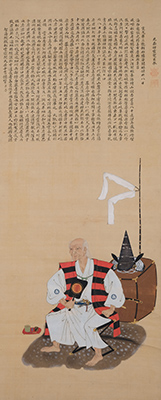
1663 (Kanbun 3)
Matsui Bunko
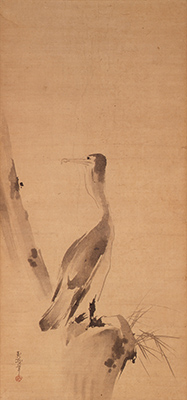
Cormorant
by Miyamoto Musashi
17th century, Edo period
Eisei Bunko Museum (Entrusted to Kumamoto Prefectural Museum of Art)

16th century, Momoyama period
Matsui Bunko
Early Summer Exhibition 2022
World of Sengai
–Humorous and amiable Zen paintings by Sengai-san
- Period
- Saturday, May 21-Monday, July 18, 2022
- Closed
- Mondays except July 18, 2022
- Opening hours
- 10:00am to 4:30pm (last entry 4:00pm)
Sengai Gibon (1750-1837) was a well-known Zen priest in the late Edo period, who preached Zen teachings through his humorous paintings and calligraphies. Eisei Bunko Museum houses more than one hundred works of Sengai collected by Hosokawa Moritatsu (1883-1970), the founder of the museum, and Sengai’s works, together with the works of another Zen priest Hakuin Ekaku, who was active during the middle of the Edo period, form the basis of the Zen art collection of Eisei Bunko Museum. In the autumn 2016, we held the first comprehensive exhibition of Sengai, which gathered wide-spread public attention.
This is the second exhibition of Zen painting collection featuring not only the best works of Sengai but also the works of the artists around him such as his fellow disciple, Seisetsu Shucho, which have not been open to the public before. We set up booths explaining the themes of Zen teachings and hold a popularity contest of the displayed objects hoping that the visitors find interest in Zen art and become familiar with the world of Sengai.
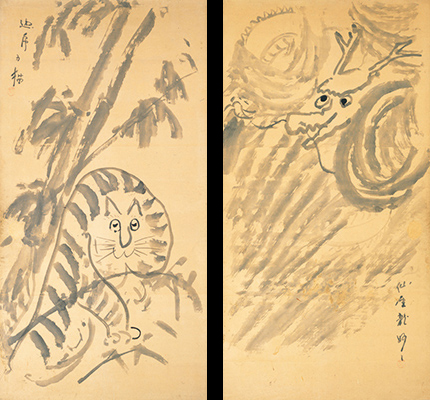
by Sengai Gibon
19th century, late Edo period
Eisei Bunko Museum
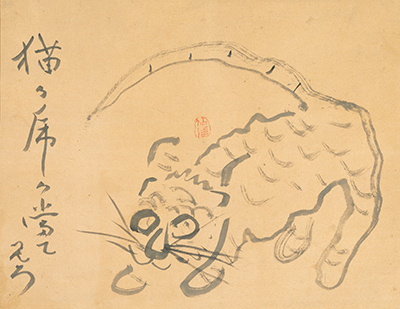
by Sengai Gibon
19th century, late Edo period
Eisei Bunko Museum
Summer Exhibition 2022
Eisei Bunko Museum Exhibition for Children & Families
- Period
- Saturday, July 30-Sunday, September 25, 2022
- Closed
- Mondays except September 19, 2022
Closed on September 20, 2022 - Opening hours
- 10:00am to 4:30pm (last entry 4:00pm)
The Hosokawa family was the lord family of the Higo-Kumamoto clan holding a fief of 540,000 koku in the Edo period, 300 years ago. What was life like for children of the Hosokawa family in those days?
Eisei Bunko Museum houses the art collection of the successive Hosokawa lords, which includes objects relating to the life of children such as portraits, calligraphic works, small kimonos, noh costumes, and photographs. This exhibition is the first attempt to introduce such objects and illustrate the daily life of a lord family
The exhibit brochure is available to young visitors so that they can enjoy the exhibition with their family and make use of their learning experience in their school assignments.
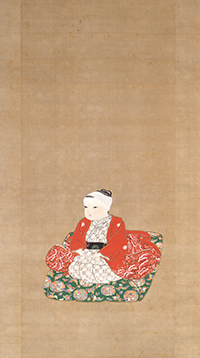
by Kano Ikei Hironobu
19th century, Edo period
Eisei Bunko Museum
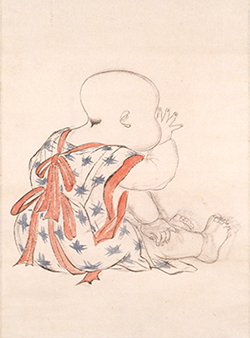
by Hosokawa Narishige
19th century, Edo period
Eisei Bunko Museum
Autumn Exhibition 2022
Lacquer Art Collection of Eisei Bunko Museum
–Exquisite masterpieces from the collection
- Period
- Saturday, October 8-Sunday, December 11, 2022
- Closed
- Mondays except October 10, 2022
Closed on October 11, 2022 - Opening hours
- 10:00am to 4:30pm (last entry 4:00pm)
People have been familiar with lacquerware since ancient times. Wide range of objects have been decorated with various lacquer techniques. Techniques such as raden (mother-of-pearl inlay), tsuishu (layers of red lacquer carved in designs), and zonsei (design painted in colored lacquer and contoured with line engraving) were developed in China, while unique method of makie (design applied by sprinkling gold, silver or colored lacquer powder) emerged and matured in Japan.
One feature of the lacquerware collection of Eisei Bunko Museum is that it holds the objects with various countries of origin. It includes items produced in Japan such as treasures of the daimyo family, horse equipments, musical instruments, and tea ceremony utensils, and also lacquerwares from China, Korea, Ryukyu, and countries in Southeast Asia. In this exhibition “Saddle with reed-script poem design in mother-of-pearl inlay” (National Treasure) is displayed in the Eisei Bunko Museum for the first time in sixteen years together with other finest works from the collection and their latest research results.
We are also pleased to present the painting, “Kannon, monkey and crane”, the first object to have been repaired under the “Restoration Project of Cultural Properties” which was launched at Eisei Bunko Museum recently. “Kannon, monkey and crane” is a noteworthy joint work painted by Yokoyama Taikan, Shimomura Kanzan, and Takeuchi Seiho, who were most distinguished painters of their time.

Saddle with reed-script poem design in mother-of-pearl inlay
14th century, Kamakura-Nanbokucho period
Eisei Bunko Museum
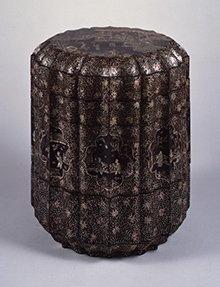
China, 13th century, Southern Song-Yuan Dynasty
Eisei Bunko Museum